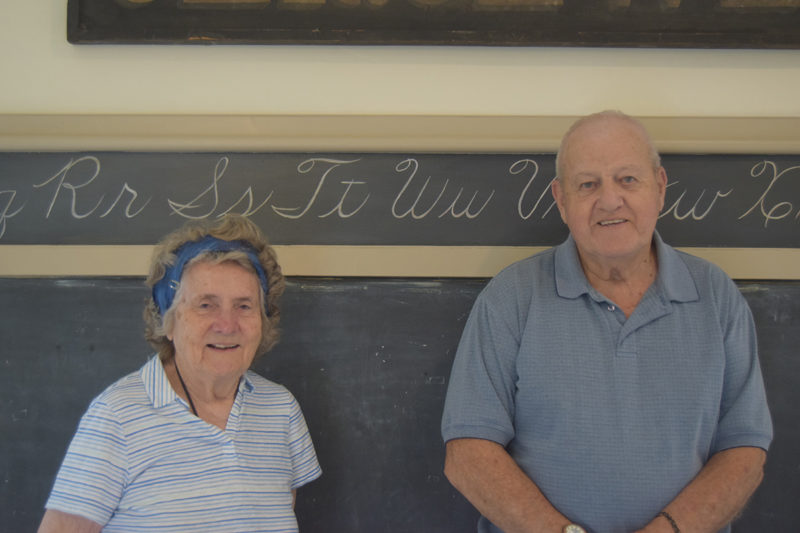
Joan Gregoire and Joseph Seigars stand in their former school Tuesday, July 30. Both were students at the Village School over 80 years ago. (Nolan Wilkinson photo)
The oak floor of Alna’s Village School at Puddle Dock lies under some checkered tiles now, but the history seeps through.
The school’s June 28 addition to the National Register of Historic Places will help keep that history preserved, according to Alna town archivist Doreen Conboy. The register is a federally-funded national program to identify and maintain historically significant buildings and locations.
“It happens to be a question on a lot of grant applications,” Conboy said. “If you’re trying to preserve a building and you need funding, a lot of times you will be asked if it’s a building that has been nationally recognized. We were very glad to get recognized in this way, which will help with the upkeep and maintenance going forward.”
The school joins the Alna Center School, Alna Meeting House, Carleton Moses House, Head Tide Historic District, and Parson’s Bend on the list of Alna’s contributions to the National Historic Register.
The school stands on Head Tide Road, directly behind the Alna Post Office in a part of town called Puddle Dock. It is one of three remaining one-room schoolhouses left in Alna, the others being Center School on Alna Road and Head Tide School, now a home, next to Head Tide Church.
Joseph Seigars, 86, lived in a house directly in front of the school as a boy, a spot that is now a cracked and overgrown patch of concrete between the post office and school.
Seigars started at the village school in the sub-primary level, equivalent to today’s kindergarten. He attended every year of education offered at the schoolhouse, through third grade.

The Village School at Puddle Dock in Alna was added to the National Register of Historic Places June 28. Built in 1874, the one room school remained in use until 1962. Typical for the period in which it was constructed, there are separate entrances for the boys and girls. The boys’ entrance is on the right. The girls’ entrance is on the left. (Nolan Wilkinson photo)
To this day, the Village School has never had indoor plumbing. Students during Siegars’ time had to leave the building to go to outhouses behind it. The outhouses were only attached to the building after state regulations passed in the 1920s required them to be, according to Conboy.
“The kids used to haul water [to the school] because there was no water,” Siegars said. “There was a farm right down the road and we would take turns hauling water.”
Seigars remembers going to the school through World War II. Although the war effort interrupted the supply of fruits like oranges and bananas as well as rationed of gasoline, he said it did not affect school much. Siegars would shelter at home after the town warden drove around honking his truck horn, which signaled residents to snuff all lights and black out their windows for fear of enemy planes overhead.
Joan Gregoire, 87, spent time as a student at both the school at Puddle Dock and the school at Head Tide. Her favorite part of learning was when the class took time to read E.B. White’s “Charlotte’s Web,” she said.
Both Siegars and Gregoire, who were separated by just one grade level, were subjected to a very different style of teaching to today’s schools.
In their school days, students could be hit with a ruler for interruptions or misbehavior.
“It didn’t take much.” Seigars said. “A misstep or just practically anything.”
Gregoire’s mother was a teacher at various schoolhouses, which were typically run by just the teacher.
Gregoire later became a teacher herself, and said schools have changed. When she taught, schools had more funding, and were able to hire secretaries and other staff. Discipline changed, the dress code was loosened, and one-room schoolhouses were phased out.
“I thought, ‘What a difference’,” Gregoire said.
By 1962, the building was no longer a school and instead served as Alna’s town office. This remained the case until 1998, when the town found accommodations with running water for the town office, according to the town website.
Conboy has overseen an effort to fix and maintain the building for years, and today the space is rentable and used for everything from yoga classes to art shows.
“There’s still no plumbing,” Conboy said. “The building hasn’t changed, it’s just what it’s being used for now.”

Different signs from the Village School at Puddle Dock’s past hang from the wall in Alna on Tuesday, July 30. The building has acted as a school, town office, art center, and it is currently available as a rentable space. (Nolan Wilkinson photo)



